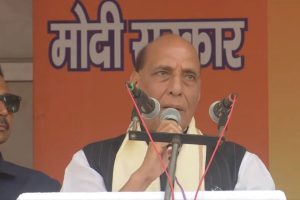We have no idea regarding the antiquity of Yoga. The popular belief is that it has come to us from God Himself. All we can say about Yoga is this that it has arrived through gurushisya parampara (teacher-student tradition) from time immemorial. Swami Vivekananda says: “Yoga can only be safely learnt by direct contact with a teacher.” It is therefore a Gurumukhi vidya. That it is extant for such a long time is proof of the fact that it is ever relevant and essential for our peaceful survival, especially the Yoga of Meditation (dhyanayoga).
Traditionally, Yoga of Meditation is non-theistic. One of its greatest exponents is Kapila. Basing Kapila, Patanjali gives his Yoga Sutras. Unlike Kapila, he, however, introduces God though as an aid for practicing concentration. His is the most popular work today. Vyasa (not the composer of Mahabharata) writes a rich commentary on it. Swamiji also writes one in English for the modern man.
Gita highlights the importance of Yoga in numerous ways. There are thought-provoking discussions on Yoga all over its text. Sri Krishna urges Arjuna to become a yogi and teaches him Yoga of Meditation for achieving the highest good. Impact of Shraddha on a practitioner of Yoga is tremendous. The word Shraddha is not translatable. It is defined as an unfaltering faith in the words of teacher. Vyasa says like an affectionate mother it intimately protects and raises a yogi.
Yoga, in a word, is concentration of mind. When the mind gets extremely concentrated it becomes supremely subtle and powerful to be able to realise the Self within. Realising the Self, it gets rid of the notion of the unreal puny self, to which it ignorantly clings and brings sufferings unnecessarily. “Wonderful is the nature of the Self,” says the preceptor of the Self.
Buddha practises Yoga of Meditation meticulously and conquers his puny self. In consequence, he attains the eternal Self. He follows the dictum, “Let a man be lifted up by his own self.” During his meditation he conducts a rigorous search into his puny self and at last discovers its falsehood. He observes that it doesn’t have any real existence at all, hence denies its existence altogether. His search, as Sri Ramakrishna has said, is like peeling an onion from its outer most covering in order to look for its core content and see a naught in the end. He, accordingly, puts forth his idea of anatta. But all he actually does is that he controls his mind and meditates to experience the ever-blissful Self in place of that puny self which causes him suffering like a mirage in the desert.
Buddha learns the technique of Yoga from an expert yogi at the outset of his peripatetic life. He in turn uses it with due expertise for the purpose of his meditation. So, his teachings are akin to the teachings of those ancient Yogis who teach to be free from dukha. The legend has it that Buddha relentlessly dances for seven days in ecstatic joy after achieving nibbana. The beatific smile on his face in his Mathura school sculptures is indeed a reflection of his perpetual blissfulness.
Buddha gives us a perfect posture for Yoga of Meditation. From his statues one could perceive what ought to be a perfect asana, firm yet relaxed and suitable for prolonged squatting. We come across the same in a photograph of Swamiji as well.
Gita defines Yoga as: “That in which the mind, restrained by concentration, rests quiescent; that in which, seeing the Self through the self, one rejoices in one’s own Self.” Thus, control of mind is its key. Therefore, we must have a clear understanding of the nature of mind first. An impure mind is not fit for the practice of Yoga.
Impurity of mind comes basically from kama (lust), krodha (anger) and lobha (greed). Krishna exhorts Arjuna to leave them, should he wish to become a yogi. Vyasa ramifies mind in its five conditions, namely, mudha (inert), kshipta (agitated), vikshipta (scattered), ekagra (one-pointed) and niruddha (absorbed/locked). The first two are not congenial to Yoga. The third one is when mind settles on a thing but shortly and then slips away. Yogi starts from here, trying to bring it back again and again in order to hold it on his chosen aspect within.
He does it till he is able to fix his mind on it for a long time. The more he resolutely endeavours the more his mind gets calm to be one-pointed. This onepointed mind, sticking to his chosen aspect, gradually loses the idea of time. His mind ripening in this position becomes absorbed and ultimately realises oneness with it. His outer consciousness now takes leave of him. As a result, he finally gains Samadhi. The yogi then realizes an omnipresent formless (nirakara) Self. His mind loses its individual identity in this state of direct perception (pratyakshanubhuti). So Swamiji remarks: “The whole theory of Yoga is to go beyond the mind.” Yogi now “rejoices in the Self and is satisfied with the Self and is content in the Self alone”. He sees “the Self in all beings, and all beings in the Self”, for he is “established in Yoga”. The goal of Yoga isn’t achieved by giving short shrift to practice and non-attachment. For its accomplishment abhyasa (practice) and vairagya (nonattachment) should go hand in hand. Sankaracharya says, “Abhyasa, practice, consists in the repetition of the same kind of thought, uninterrupted by any contrary thought, with regard to the aspect of concentration.” Vairagya, says Patanjali, “comes to those who have given up their thirst after objects (vishaya), either seen or heard”. Swamiji tells us: “Non-attachment is the basis of all the Yogas.” The slightest trace of attachment to worldly enjoyment remaining, Yoga remains a far cry, says Sri Ramakrishna. Therefore, renunciation is its hallmark. “When the well-controlled mind rests in the Self alone free from longing for objects, then is one said to have attained Yoga,” tells the Gita.
Pranayama is synonymous with Yoga. Prana is the vital energy which sustains life. It has five modifications depending on its five different functions. Namely, prana controls breath, apana carries down unassimilated food; samana carries nutrition all over the body; vyana pervades the entire body; and udana ejects the content of the stomach. Pranayama generally means control of prana in order to have control over the body. However, in the case of Yoga of Meditation “all the objects of the senses, as also all the actions of the body, together with the functions of the prana, are dissolved in meditation, made one-pointed by discriminative wisdom.” Hence there is no need to go separately through any exercise for pranayama in it.
But then there are certain truths about which its aspirant must stay on the alert while practising. For example, “Yoga is not for him who eats too much nor for him who eats too little. It is not for him… who sleeps too much nor for him who sleeps too little.” Krishna teaches: “For him who is temperate in his food and recreation, temperate in his exertion at work, temperate in sleep and waking, Yoga puts an end to all (his) sorrows.”
This resembles the Middle Path preached by Buddha. Middle Path is the net result of Buddha’s experiment with himself. He begins adopting extreme austerity and finds it obstructive to meditation. It weakens his body and mind, without the help of which Yoga is impossible. He next tries afresh, taking in food in just the quantity needed to maintain his body and mind sound and strong for pursuing a proper practice.
There is a scripture which compares Yoga with a fire that consumes ignorance and purifies knowledge for obtaining Nirvana directly. It says Lord is pleased with one who combines both Yoga and knowledge in him. It concludes: “Yoga is divided into two parts. One is called Abhava, and the other, Mhahayoga. Where one’s self is meditated upon as zero, and bereft of quality, that is called Abhava.
That in which one sees the self as full of bliss and bereft of all impurities, one with God, is called Mahayoga. The Yogi, by each one, reaches his Self. …the excellent Mahayoga in which the Yogi finds himself and the whole universe as God. This is the highest of all Yogas.” Yoga of Meditation is a passage that takes us out of our sufferings definitely. It extinguishes all our miseries and puts us in a state of undying peace and tranquillity. Its necessity in this stressful world is inexorable.
The writer is with the Ramakrishna Mission, Narendrapur











